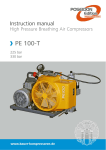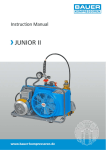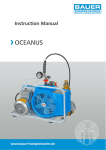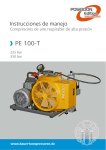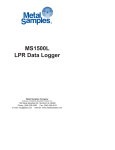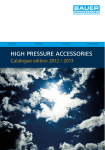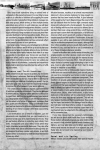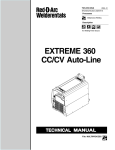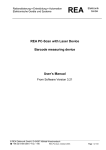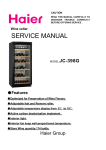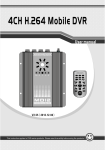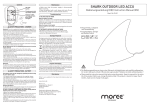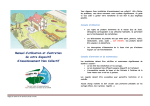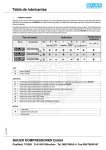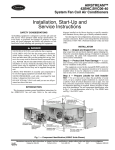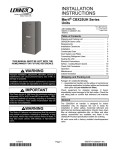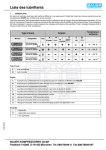Download Instruction manual
Transcript
Instruction manual High Pressure Breathing Air Compressors Instruction Manual w PE 100-T INTRODUCTION This manual contains operating instructions and maintenance schedules for the high pressure breathing air compressor unit PE 100-T WARNING ! Pneumatic high pressure system ! The breathing air produced with the compressor units de scribed in this manual is subject to strict quality standards. Ignoring the operating and maintenance instructions can lead to severe injury or death. This compressor has been built in accordance with the EC ma chine regulations 2006/42/EG. Specifications on the noise level in accordance with the machine and product safety law as of 01.05.2004 and the EC machine regulations, chapt. I, section 1.7.4. The machine has been built according to the highest standard of technology and the generally acknowl edged safety standards. Nevertheless, operation could still cause danger for the operating personnel or third parties, or result in damage to the machine and other values. The ma chine may only be used to produce compressed air as speci fied in this manual. Other use is strictly prohibited. All instructions should be observed and carried out in the or der laid down to prevent damage and premature wear to the equipment. The manufacturer and the supplier void all responsibility for damage or injury resulting from failure to follow these instruc tions. Edition January 2010 © 2010 BAUER Kompressoren GmbH, München All rights reserved i Instruction Manual w PE 100-T Dear customer We are happy to give you advice on any questions regarding your BAUER compressor and help as soon as possible with any arising problems. You can contact us Mondays to Thursdays from 0800 till 1630, Fridays from 0800 till 1400 on phone no. (089) 78049-0. If you call the following extensions directly, it will save you time and continuous dialling. Do you want to order spare parts? Customer service Phone no: (089) 78049-129 or -149 Fax no: (089) 78049-101 Do you have problems with maintenance or repair work? Technical customer service Phone no: (089) 78049-246 or -176 Fax no: (089) 78049-101 Do you need further information regarding your unit, ac cessories, prices etc.? Sales department Phone no: (089) 78049-138, -185, -154, -205 or -202 Fax no: (089) 78049-103 Are you interested in any training courses? Training manager Phone no: (089) 78049-175 Fax no: (089) 78049-103 Explanation of the short operating instructions on the unit Operate unit only at ambient tem peratures between +5 and +45 °C Check oil level on compressor and petrol engine before operating unit chapter 3. Keep away from hot surfaces on motor and compressor chapter 2. Drain condensate at least every 15 minutes (3 locations) chapter 4.4.3. and 4.4.4. Wear ear protectors when unit is running Change satured filter cartridge chapter 2. Position unit level: max. inclination 5° chapter 3. Read instruction manual before op erating unit chapter 3. Kapitel 4.4.4. Petrol driven units must not be oper ated indoors. chapter 3. Position units with petrol engine with exhaust in wind direction to prevent exhaust fumes being sucked in by the compressor ii chapter 4.4.1. chapter 3. Instruction Manual w PE 100-T CONTENTS 1. 2. 3. 4. 5. 6. 7. 8. GENERAL . . . . . . . . . . . . . . . . . . . . . . . . . . . . SAFETY MEASURES . . . . . . . . . . . . . . . . . . . . LOCATION, OPERATION, BOTTLE FILLING . . . MAINTENANCE . . . . . . . . . . . . . . . . . . . . . . . STORAGE, PRESERVATION . . . . . . . . . . . . . . . REPAIR INSTRUCTIONS . . . . . . . . . . . . . . . . . . TABLES . . . . . . . . . . . . . . . . . . . . . . . . . . . . . . ANNEX . . . . . . . . . . . . . . . . . . . . . . . . . . . . . . 1 5 9 14 28 29 30 33 INDEX A Adhesive chart, 31 Air flow diagram, 3 Annex, 33 C Cooling system, 25 D Design, 1 Drive system, 24 E V-belt, tension meter, 24 Electrical system, 25 F Filling procedure, 10 Filter system, 16 I Intake filter, 15 Intermediate separator, 16 Intake air quality, 10 L Location, 9 Lubrication, 14 Lubrication chart, 31 M Maintenance, 14 Maintenance instructions, 14 Maintenance record, 14 Maintenance schedule, 14 Motor protection switch, 25 O Oil change, 14, 15 Oil level check, 14 Oil type, 14 change of, 15 Operation, 9 P Preservation, 28 Pressure gauge, 22 Pressure-maintaining valve, 21 R Repair instructions, 29 S Safety valves, 21 Sealant chart, 31 Storage, 28 T Tables, 30 Technical data, 4 Telescopic intake tube, 15 Testing agents, 31 Tightening torque values, 30 Torque sequence, 30 Trouble-shooting, 26 V Valves, 22 ANNEX Schematic diagram motor protection switch, three phase current Lubricating oil list Applicable parts list 76942-S1 70851 TPE100-1/0 iii Instruction Manual w PE 100-T NOTES Model: Serial No..: Date of purchase: Dealer address / phone no.: iv Instruction Manual w PE 100-T 1. GENERAL PURPOSE The PE 100-T breathing air compressor is designed to com press air for breathing as required in diving applications. The max. allowable operating pressure (adjusted pressure on final pressure safety valve) is 225 bar or 330 bar. DESIGN The compressor unit comprises the following major assem blies: - compressor block - drive motor - filter system P11 - filling assembly - frame The design of the compressor system is shown in Abb. 1 to Abb. 3. 1 4 5 6 2 3 7 8 Abb. 1 1 2 3 4 Compressor unit with electric motor (three-phase current) Filling valve with final pressure gauge Drive motor Frame Pressure maintaining valve 5 6 7 8 Filter system P11 Safety valve, final pressure Condensate drain tap, final separator Condensate drain tap, intermediate separator 1 Instruction Manual w PE 100-T 5 6 7 1 2 3 4 5 6 7 8 10 8 4 Filling hose Filter system P11 Safety valve, final pressure Pressure maintaining valve Oil dipstick Intake filter Filling valve with pressure gauge Handle Mains plug with ON-OFF switch and motor protection circuit breaker (dep. on country) 3 9 2 1 Abb. 2 1 2 3 4 5 6 7 8 Compressor unit with electric motor (three-phase current) Drive engine Filling valve with pressure gauge Handle Pressure maintaining valve Filter system P11 Fanwheel cover Condensate drain tap, intermediate separator Condensate drain tap, final separator 2 3 4 5 6 1 7 8 Abb. 3 2 Compressor unit with petrol engine Instruction Manual w PE 100-T AIR FLOW DIAGRAM See Abb. 4 . The air is drawn in through telescopic tube (necessary for units with petrol engine) -1, intake filter -2; compressed to final pressure in cylinders -3, -4, -5; recooled by intercoolers -6, -7, and aftercooler -9. The pressures of the single stages are protected by safety valves -10, -11, -12. The compressed air is pre-cleaned in intermediate separator -8 and purified in filter system P11 -13. Intermediate separator and filter system P11 are drained by means of condensate drain taps -14 and -15 respectively. Pressure maintaining valve -16 provides a constant pressure within the filter assem bly. The compressed, purified air is passed through filling hose -17 and filling valve -18 to the bottles to be filled. Filling pressure is indicated at pressure gauge -19. 1 18 19 17 6 16 2 3 9 20 10 11 12 5 8 4 13 14 7 15 Abb. 4 1 2 3 4 5 6 7 8 9 10 Air flow diagram Telescopic air intake Intake filter Cylinder 1st stage Cylinder 2nd stage Cylinder 3rd stage Inter-cooler 1st/2nd stage Inter-cooler 2nd/3rd stage Intermed. separator 2nd/3rd stage After-cooler Safety valve 1st stage 11 12 13 14 15 16 17 18 19 20 Safety valve 2nd stage Final pressure safety valve Filter system P11 Condensate drain tap, intermediate separator Condensate drain tap, final separator Pressure maintaining valve Filling hose Filling valve Filling coupling Final pressure gauge 3 Instruction Manual w PE 100-T TECHNICAL DATA Compressor unit Medium Delivery a) Operating pressure Pressure setting, final pressure safety valve Sound pressure Sound (immersion) power Weight Compressor block Number of stages Number of cylinders Cylinder bore 1st stage Cylinder bore 2nd stage Cylinder bore 3rd stage Piston stroke Speed Intermediate pressure 1st stage Intermediate pressure 2nd stage Compressor block oil capacity Oil volume between min. and max. marks Oil type Max. ambient temperature Max. inclination of compressorb) Max. operating height 87 dB(A) 100 dBA) 42 kg PE 100-TE-F02 PE 100-TW-F02 air 100 l/min. (3,5 Scfm) PN200/PN300 225/330 bar 86 dB(A) 99 dB(A) 44 kg 44 kg Junior II-V001, mod. 3 3 3 60 mm 28 mm 12 mm 24 mm 2,300 min-1 6-7 bar 40-60 bar 360 ml 50 ml see chapter 4.4.1. lubrication +5 ... +45 °C 5° 0 ... 2000 m above sea level Compressor drive Drive motor Manual start model (B) Power at nominal speed PE 100-TB-F02 Robin/Subaru petrol engine EX17 4.2 kW (5.7 PS) 3,600 min-1 Compressor drive Drive motor Operating voltage Power Speed Size Type of construction Type of enclosure PE 100-TE-F02 Three phase current 400 V, 50 Hz 2.2 kW (3 PS) 2,850 min-1 90 L B3 IP54 Compressor drive Drive motor Operating voltage Power Speed Size Type of construction Type of enclosure PE 100-TW-F02 Alternating current 230 V, 50 Hz 2.2 kW (3 PS) 3,000 min-1 LS 90 PC B3 IP44 a) b) 4 PE 100-TB-F02 free air delivered at bottle filling from 0 to 200 bar "5% these values are valid only if the oil of the compressor in normal position corresponds with the upper mark of the oil dipstick and may not be exceeded. Instruction Manual w PE 100-T 2. SAFETY MEASURES 2.1. NOTES AND WARNING SIGNS Notes and warning signs displayed on compressors accord ing to model, application or equipment. This notice is used with maintenance work and operating procedures and must be adhered to exactly in order to avoid endangering personnel. WARNING WARNING Hot surfaces, do not touch! This notice must be complied with in order to avoid damage to or destruction of the machine or its equipment. Danger of burning by touching cylinders, cylinder heads and pressure lines of individ ual compressor stages. WARNING This notice advises of technical requirements which the operator must take particular note of. High voltage! Life threatening danger of electric shock. Maintenance work on electric units or op erating equipment may only be carried out by a qualified electrician or by a person instructed and supervised by a qualified electrician according to electrical regula tions. WARNING Automatic compressor control, unit may start-up without warning! Before carrying out maintenance and repair work, switch off at the main switch or dis connect from the mains and ensure unit will not restart. MANDATORY Instructions must be read by persons oper ating the machinery! The instruction manual supplied and all other applicable instructions, regulations etc. must be read and understood by oper ating personnel before using the machine. MANDATORY 2.3.1. Authorized use • The machine / unit is built according to state of the art technology and established safety technical regulations. Nevertheless, its use can cause danger to life and limb of the operator or third parties or damage to the machine and other equipment. • Operate the machine / unit only in technically perfect condition in accordance with regulations and safety and danger notices detailed in the instruction manual! In par ticular, immediately correct faults (or have them cor rected) which can impair safety! • The machine / unit is exclusively for the compression of mediums (air/gas) specified in section A, chapter 1.3. “Technical data”. Any other medium or use outside that specified is not authorized. The manufacturer / supplier is not liable for damage resulting from this. The user alone is responsible for this risk. Authorization for use is also under the condition that the instruction manual is com plied with and inspection and maintenance requirements are enforced. 2.3.2. Organizational measures Hearing protectors must be worn when working on a machine which is running. • Keep the instruction manual to hand near the machine / unit at all times in the relevant holder. • In addition to the instruction manual, observe and com ply with universally valid legal and other obligatory re gulations regarding accident prevention and environ ment protection. See chapter 2.4. This can involve, for example, contact with hazardous substances or the provi sion / wearing of personal protective equipment. • Personnel engaged to operate the machine must have read the instruction manual before beginning work, es pecially the safety notices chapter. When work is already underway it is too late. This is particularly relevant for temporary personnel, e.g. maintenance personnel. • Personnel may not wear long hair loose, loose clothing or jewellery, including rings. There is a danger of injury Ensure correct direction of rotation! When switching on the machine, check the arrow to ensure correct direction of rota tion of the drive motor. MV3−A/10/06 FUNDAMENTAL SAFETY NOTICES Hearing protectors must be worn! NOTE 2.2. 2.3. IDENTIFYING THE SAFETY NOTICES Important instructions concerning the endangerment of per sonnel, technical safety and operating safety will be specially emphasized by placing the following signs before the instruc tions. 5 Instruction Manual w PE 100-T through, for example, these getting caught or being pulled into the equipment. • As far as necessary or according to regulations, use per sonal protective equipment. • Observe all safety and danger notices on the unit. ately if anything is not as is should be (including oper ation). If necessary, shut the machine down immediately and make it safe. • Observe switching on and off processes and monitoring indications according to the instruction manual. • Keep all safety and danger notices on the machine / unit complete and in readable condition. • Before switching on / starting up the unit, ensure that no one can be put at risk through running the unit. • If there are any modifications to the unit or operating conditions which may affect safety, stop the unit immedi ately and inform the person responsible of the fault. • Carry out the setting, maintenance and inspection pro cesses at the intervals specified in the instruction manual, including replacement of parts / equipment. This work may only be carried out by qualified personnel. • No modifications may be made to the unit which could impair safety without first obtaining permission from the suppliers. This is also the case with regard to installation and adjustment of safety devices and valves as well as welding of piping and reservoirs. • Spare parts must always comply with the technical re quirements specified by the manufacturer. This is always guaranteed with original spare parts. • Piping must be thoroughly checked (pressure and visual inspection) by the operator at appropriate time intervals, even if no safety related faults have been noticed. • Intervals stipulated or given in the instruction manual for recurring checks / inspections must be adhered to. • Make sure location and operation of fire extinguishers is known. • Pay attention to fire warning and fire fighting procedures. 2.3.3. Qualifications, fundamental duties • Work on / with the unit may only be carried out by reliable personnel. Observe the legal minimum age permissible. • Ensure that only trained personnel work with the ma chine. • Establish the responsibilities of the machine operator and establish a procedure for him to inform a third person of unfavourable safety conditions. • People who are being trained or introduced to the job should only be allowed to work with the unit under con stant supervision of an experienced person. • Work on the electrical equipment of the unit may only be carried out by a qualified electrician or by an instructed person under the direction and supervision of a qualified electrician according to electrotechnical regulations. 2.3.4. Safety notices for operation • Do not carry out any work if safety is questionable. • Clear and make the maintenance area safe as far as necessary. • If the unit is completely switched off for maintenance and repairwork, ensure that it is protected from unexpected start-up. Turn off main control device and remove the key and / or display a warning sign on the main switch. • When replacing individual parts and larger assembly groups, they must be carefully fastened to the lifting de vice so that there is no risk of danger. Use only suitable and technically perfect lifting devices and equipment with sufficient lifting power and strength. Do not linger or work under suspended loads. • Only entrust an experienced person with the fixing of loads and guiding of crane drivers. The person guiding must remain within sight or in contact with the operator. • For assembly work above body height, use appropriate safety approved equipment, e.g. ladders and platforms. Do not climb on machine parts. For maintenance work at high levels, wear a safety harness. • Clean oil, fuel or care products from the machine, in par ticular the connections and screw joints, before carrying out maintenance / repairwork. Do not use aggressive cleaning fluid. Use a fibre-free cleaning cloth. • Before cleaning the machine with water or jet of steam (high pressure cleaner) or detergent, cover / seal all open ings which for safety and/or operating reasons no water / steam / detergent may penetrate. Electric motor and switch cabinets are particularly at risk. • When cleaning the operating room, ensure that the tem perature sensors of the fire alarm and sprinkler system do not come into contact with hot cleaning fluid, in order to avoid triggering the sprinkler system. • Completely remove all covers / seals after cleaning. • After cleaning, check all pressure lines for leaks, loose connections, wear and damage. Immediately eliminate any faults. • Meet all requirements demanding that the unit is only op erated in safe and good working order. Only operate the machine if all protective and safety equipment, e.g. all de tachable protective equipment, emergency shut-down devices, soundproofing is provided and in good working order. • Always retighten any screw connections loosened for maintenance or repairwork. • At least once every day, check the unit externally for dam age and faults. Inform the person responsible immedi • Ensure safe and environmentally friendly disposal of con sumables and old parts. 6 • If it is necessary to remove safety devices for maintenance and repairwork, these must be replaced and checked im mediately after completion of the maintenance or repair work. Instruction Manual w PE 100-T 2.3.5. Particular areas of danger • Use only original fuses with specified current rating. If there is a failure in the electric energy supply, shut the unit down immediately. • Work on electric units or operating equipment may only be carried out by a qualified electrician or by a person under the instruction and supervision of a qualified elec trician according to electric technical regulations. • Machines and unit parts which must undergo inspection, maintenance and repairwork, must be disconnected from the mains supply, if specified. Parts which have been disconnected must first be checked for voltage, then earthed and short-circuited and isolated from live neigh bouring parts. • The electrical equipment of a unit must be regularly checked. Defects, such as loose screw connections or burnt wires, must be rectified immediately. • If work is to be carried out on live parts, work with a sec ond person who can operate the emergency off switch or the main switch in the case of an emergency. Close off the work area with a red and white safety chain and a warn ing sign. Only use voltage isolated tools. • Only personnel with particular knowledge and experi ence with pneumatics may carry out work on pneumatic equipment. • Check all pressure lines, hoses and screw connections regularly for leaks and visible damage. Immediately repair any damage. Escaping air under pressure can cause injury and fire. • Depressurize system and pressure lines before commenc ing repairwork. • Pressurized air lines must be laid and mounted by quali fied personnel. Connections must not be mixed up. Fit tings, length and quality of the piping must correspond to requirements. • Soundproofing equipment on the unit must be in place and functional during operation. • The stipulated hearing protectors must be worn. • With regard to oil, grease and other chemical substances, observe the relevant safety regulations for the product. • For loading, only use lifting device and equipment with sufficient lifting power and strength. • Use only suitable transporters with sufficient carrying power. Secure the load properly. Use suitable fixing points. • If necessary, provide unit with transportation brackets. Display the appropriate notice. Remove transportation brackets in the correct manner before taking into oper ation. • Parts which need to be dismantled for transport purposes must be carefully replaced and secured before taking into operation. • Even when moving the unit only slightly, the unit must be disconnected from all external energy sources. Before putting into use again, reconnect the machine to the mains according to regulations. • When taking back into operation, proceed according to the instruction manual. 2.3.6. Notices of danger regarding pressure vessels • Never open or loosen pressure vessel lids or pipe connec tion parts under pressure; always depressurise the vessel or the unit. • Never exceed the permissible operating pressure of the vessels! • Never heat the vessels or any of their parts above the stated, maximum operating pressure. • Always exchange damaged pressure vessels completely. Individual parts that are subject to pressure loads cannot be purchased as spare parts, since the vessels are tested as a complete part and the documentation considers them as a whole (see pressure vessel documentation, serial-numbers!). • Always pay attention to the permissible operating mode of the pressure vessels. We differentiate: - vessels for static load - vessels for dynamic load Vessels for static load: These pressure vessels are permanently under virtually constant operating pressure; the fluctuations of pressure are very small. Vessels for this type of load are not marked in a particular way and may be used as long as the vessel inspections, carried out regularly, do not uncover any safety-relevant deficiencies. We recommend that aluminium vessels should be exchanged after 15 years at the latest. Vessels for dynamic load: These pressure vessels may also be used under conditions of changing operating pressure. The pressure may vary between the atmospheric and the maximum admissible operating pressure. The pressure vessel documentation and the appropriate notes in the operating manual particularly characterise vessels of this type as being adequate for dynamic loads. In the technical information for these vessels you will find specifications concerning their permissible operating period. Due to the variation of the operating pressure, these vessels are subject to a so-called dynamic load, which puts the vessels under great stress. The change between two different pressures is called a load change or cycle. In the technical information for these vessels you will find specifications concerning the permissible number of cycles depending on the fluctuation of the operating pressure. Having reached half the permissible number of cycles, the vessel has to be submitted to an internal check, in which the critically stressed areas of the vessels are examined by means of suitable testing methods, in order to ensure the operating safety. 7 Instruction Manual w PE 100-T After having reached the total permissible number of load cycles, the vessel must be exchanged and scrapped. Record the number of load cycles in writing if you do not have an automatic cycle-counter. We recommend that aluminium vessels should be exchanged after 15 years at the latest. Please pay attention to and follow these measures, for your own safety and that of you employees and cus tomers! In order not to unnecessarily load the pressure vessels additionally, the non-return valves, that are meant to avoid a drop in pressure, and also the pressure maintain ing valves, which should reduce big pressure fluctuations as well, should be checked regularly for internal and ex ternal tightness and functionality. • Check the pressure vessels regularly on the inside and out side for damage from corrosion. • Be particularly careful with second-hand pressure vessels, when their previous operating mode is not specifically clarified. 2.4. SAFETY REGULATIONS (EC; partly Germany, only) A compressor is identified by German law as being a filling system if pressure cylinders are filled by the system, especially when these cylinders are made available for third parties. The start-up and operation of compressor systems for use as fill ing stations is governed by the following regulations: Pressure vessel directive (Directive 97/23/EC) of 29.05.1997 Operating safety regulations (BetrSichV) of 27.09.2002 Machine safety law (GSG) of 11.05.2001 14th regulation to machine safety law (14. GSGV - pres sure vessel regulation) of 03.10.2002 Technical regulations for pressure gases (TRG 400, 401, 402, 730). If a high pressure compressor is used for filling pressure vessels or for the supply of pneumatic systems, the following regulations apply: Accident Prevention Regulations (UVV): BGV A1 of 01. January 2004 Copies of the above regulations are available through the usual outlets, e.g. in Germany from: Carl Heymanns Verlag Luxemburger Str. 449 50939 Köln Beuth-Vertrieb GmbH Burggrafenstr. 4 - 7 10787 Berlin The manufacturer has complied with all applicable regula tions and the unit is prepared accordingly. If desired, we offer at our Munich site a partial acceptance test according to § 8 14 BetrSichV. Please contact our Technical Service Depart ment with regard to this. They can also supply our leaflet “IMPORTANT NOTES FOR CERTIFICATION”. According to the operation safety regulations (BetrSichV), all compressor units which will be used as filling stations must undergo an acceptance test by a professional at their loca tion before bringing them into service. If pressure vessels (bottles) are to be filled by the compressor for a third party then the appropriate permission must be obtained from the responsible authority before the acceptance test. As a rule, this is the factory inspectorate. The procedure for obtaining permission is according to TRG 730, guidelines for permission to set up and operate filling stations. The test certificates and documents delivered with the compressor are important and may be requested during the procedure for obtaining per mission. In addition, the documents belonging to the unit are important for recurrent inspections and should therefore be carefully kept. Inspections in accordance with the regulations for preven tion of accidents will be carried out by the manufacturer or by a specialist. No guarantees whatsoever are valid for damage caused or favoured by the non-consideration of these directions for use. We strongly emphasize these regulations. Instruction Manual w PE 100-T 3. LOCATION, OPERATION, BOTTLE FILLING 3.1. LOCATION - 3.1.1. Outdoor location The compressor unit is not seawater resis tant. At operation in salty air spray com pressor with anticorrosive protection (see accessories catalog, available over the cu stomer service). Electric driven units should be operated and stored below deck in dry atmo sphere. Units with petrol engine should also be stored below deck after the filling process. WARNING - - Keep unit away from inflammable items. Do not smoke while petrol tank is open and while unit is in op eration. Locate the unit level. On units with petrol engine it is most important that only clean air be used, position compressor in direction of wind so that exhaust fumes are blown away from the unit. Turn unit as soon as wind direction changes. Take care that no vehicles are in direct vicinity with en gines running. Do not operate unit in the vicinity of open fire (flue gas!). - - - Comply with regulations of local electricity supply com pany. Arrange for the electrics to be connected by an electrician only. Ensure correct installation of protective conductor. Check conformity of motor tension and frequency with those of electric network. Operate electric units only on mains sockets equipped with fault current circuit breaker according to DIN VDE 0664 with a nominal differential current of less than 30 mA (up to 16 A in single-phase AC circuits). For units not connected through a plug, but permanently installed, a main switch must be provided which has a contact gap of minimum 3 mm on each pole. Fuse motor correctly; use safety fuses, only. Immediately after start-up check direction of rotation for agreement with arrow on unit. If power supply cable is to be replaced, use cable of same type, only! - When using extension leads or cable drums, operate unit with unwound cable, only to avoid overheating and risk of fire. The maximum length for extension cables at nor mal ambient temperatures (approx. 20 °C) is 25 metres. 3.2. OPERATION 3.2.1. Preparation for operation 3.1.2. Indoor location WARNING - - Petrol driven units must not be oper ated indoors. Ensure adequate ventilation. Here too, air must be free from exhaust fumes and haz ardous vapours (e.g. smoke, solvent vapours, etc.). If possible install unit in such a manner that the com pressor fan can get fresh air from outside, for instance through an opening in the wall. Ensure that an adequate exhaust air opening is provided. When locating the compressor in small rooms where natural ventilation is not ensured, measures must be taken to provide artificial ventilation (this also applies when other systems having high radiation are operating in the same room). See Installation manual, available over the customer service. 3.1.3. Electrical installation For installation of electrical equipment observe the follow ing: All compressor units are tested prior to de livery to the customer, so after correct in stallation of the unit there should be no problem putting it into operation, observing the fol lowing points: The compressors described in this manual are not suitable for com pression of oxygen and nitrox gas mixtures. EXPLOSION occurs if an oil lubricated com pressor is operated with pure oxygen or gases with an oxygen content of more than 21%! WARNING - - - Prior to first operation read Instruction Manual carefully. Make sure that all persons handling the compressor and the filling station are familiar with the function of all con trols and monitors. Particularly observe chapter 2 SAFETY REGULATIONS. After taking unit into operation after a standstill period of 2 years or more change compressor oil. When using a mineral oil change oil after one year. Prior to first operation or operation subsequent to repair work operate unit for at least 1 minute with open conden sate valves (pressureless) to ensure proper lubrication of all parts before pressure is built up. 9 Instruction Manual w PE 100-T - - Prior to each operation check the oil level according to chapter 4.4.1. and determine whether maintenance is necessary in accordance with the service manual. Every time the unit is started up check all systems for proper operation. If any malfunction is observed stop unit immediately and find the cause of the fault or call the ser vice department. Units with three phase current motor, additionally: - Immediately after switching on the system for the first time check the direction of rotation of the motor for com pliance with the arrow on the unit. If motor turns in the wrong direction, the phases are not connected properly. Shut down unit immediately and interchange two of the three phase leads (L1, L2, L3) in the motor protection switch. Never change leads at the motor terminal board. Units with petrol engine, additionally: - Check engine oil level according to manufacturer's in struction manual. Check fuel tank. Top up if necessary. Open fuel shut-off valve. 3.3. FILLING PROCEDURE 3.3.1. General Ensure intake air is free from WARNING noxious gas (CO), exhaust fumes and solvent vapour. On units employing petrol or diesel engine it is most important to use an intake hose and observe that only clean air is drawn in. The intake hose is also recommended for units with electric engine. When operating the unit in areas with possibly high CO contents, the CO removal filter car tridge is recommended for electric driven units, also. Note that for CO contents of more than 25 ppmV in the intake air the allowed limits cannot be guaranteed even with a CO removal filter cartridge, resulting in a lifethreatening CO concentration! Also, due to chemical re action of CO with hopcalite, warming up of the car tridge and danger of fire may result. Please respect local regulations for WARNING filling hoses. Filling hoses must be in satisfactory condition and threads undamaged. Pay particular attention to damage on the interface from hose fitting to hose. If the casing is scored or the hose is porose, hose must be discarded. The filling valve connection is of the manual type and permits connection to air tanks without using tools. An O-ring is pro vided for self-sealing due to internal overpressure. Com pressed air tank filling valves for a pressure in excess of 200 bar are standardized (DIN 477, sheet 5) and connectors for 200 and 300 bar are different and cannot be mixed up. The use of adapters is not allowed! To ensure safe air tank removal after filling, the valve has an integral venting bore. Therefore always close tank valve first before closing filling valve. During filling procedure bottles 10 will warm up due to recompression. After removing, allow to cool down, bottles may then be reconnected and topped up to the respective maximum filling pressure. To meet the CO2 maximum rating value in breathing air bottles, please observe the two following chapters ”Intake air quality” and ”Scavenging the compressor unit”. WARNING 3.3.2. Breathing air quality The breathing air quality is a safety hazard. The prescriptive limits of the minor consti tuents must be measured regularly (see service manual for measure intervals). The norm DIN EN 12021 is the actual regulation for natural breathing air from compressors and air bottles: Prescriptive limits for natural breathing air ac cording to DIN EN 12021 Constituents Limits H2O concentration: - direct from compressor 25 mg/m3 - from a 200 bar cylinder 50 mg/m3 - from a 300 bar cylinder 35 mg/m3 Oil concentration 0,5 mg/m3 CO concentration < 15 ppm CO2 concentration < 500 ppm We recommend the breathing air controller “Aerotest” from the company Dräger (see accessories catalog, available over the customer service). All breathing air control has to be recorded with date and va lues of the measures. In case of overstepping the prescriptive limits, see chapter 4.5. Trouble-shooting 3.3.3. Intake air quality Ensure intake air is free from noxious gas (CO), exhaust fumes and solvent vapour. On units employing petrol or diesel engine it is most important to use an intake hose and observe that only clean air is drawn in. The intake hose is also recommended for units with electric engine. When operating the unit in areas with possibly high CO contents, the CO removal filter car tridge is recommended for electric driven units, also. Note that for CO contents of more than 25 ppmV in the intake air the allowed limits cannot be guaranteed even with a CO removal filter cartridge, resulting in a lifethreatening CO concentration! Also, due to chemical re action of CO with hopcalite, warming up of the car tridge and danger of fire may result. WARNING At routine tests, CO2 values beyond the permissible values are noted from time to time. Closer investigations often show Instruction Manual w PE 100-T that the compressed air is taken from rooms in which one or more persons are working. At insufficient ventilation, the CO2 value in the surrounding air can increase quite fast be cause of the exhaling of CO2. CO2 values from 1,000 to 5,000 ppmv in workrooms are not unusual (MAK-value (max. work room concentration) is 5,000 ppmv). Another additional in crease is caused by cigarette smoking, producing approx. 2g CO2 ( 2,000 ppmv) per cigarette. These pollutions add up to the basic pollution of approx. 400 ppmv. The technically caused excessive increase of CO2 during the filling process and the CO2 peak at taking the unit into operation. Because of the reasons stated above and for your own security, the filling of breathing air bottles is not allowed in rooms used as workrooms. 3.3.4. Scavenging the compressor unit • PE 100-TB: Shift switch (1, Abb. 7) to position I. Set choke (2, Abb. 7) to position START. Start engine with recoil starter. As soon as motor runs smoothly return choke to normal operating position. 2 1 Abb. 6 CO2 is present in the atmosphere with a natural amount of 350 to 400 ppmV. The molecular sieve used in the purifier for drying the breathing air is, as well as other capabilities, able to adsorb CO2 which is accumulated in the cartridge. After shut-down of the compressor, adsorbed CO2 may be de sorbed again due to the partial pressure decrease. The now free CO2 then gets washed out of the cartridge when the compressor is started again. To avoid increased CO2 contents in the compressed breathing air, we recommend to flush the compressor unit 1 to 2 minutes prior to connecting the bottles, i.e. to let the air escape into the surroundings. Motorschutzschalter 2 1 Scavenging procedure 1. Ensure that no bottle is connected to the compressor. Abb. 7 2. Open condensate drain tap (1, Abb. 5) of interme diate separator (on petrol units additionally the con densate drain tap (2, Abb. 5) of final separator) to unload the compressor during the starting phase. 1 Abb. 5 3. Petrol engine 4. As soon as final speed is reached close condensate drain tap (1, Abb. 5) of intermediate separator (on petrol units additionally the condensate drain tap (2, Abb. 5) of final separator). 5. Open filling valve (Abb. 8), wait until air escapes and flush the compressor unit 1 to 2 minutes, i.e. let the air escape into the surroundings. 2 Condensate drain taps Switch on the unit: • PE 100-TE: Shift switch (1, Abb. 6) to position I. • PE 100-TW: Press switch (2, Abb. 6) to position I. Abb. 8 Scavenging 1 11 Instruction Manual w PE 100-T 6. Close filling valve and start promptly the filling proce dure. See Filling the bottles. 2. 3.3.5. Filling the bottles Scavenge the compressor prior to connec ting the bottle if the unit has been put out of service for more than several hours. See 3.3.4. On models of 300 bar rated filling pressure do not attach bottles unless rated for this pressure (note pressure stamped on tank neck). 1. 1. Abb. 11 Filling air bottle Connect air bottle to filling valve. See Abb. 9. 3. Abb. 9 Ensure that condensate drain tap (1, Abb. 12) of in termediate separator is open. On petrol units open additionally the condensate drain tap (2, Abb. 12) of final separator. Connecting air bottle The international connector (Abb. 10) is not permitted in the Federal Republic of Germany. In other countries it is allowed only for pressures up to 200 bar (2,850 psi). 1 2 Abb. 12 Condensate drain taps 4. Switch on the unit: • PE 100-TE: Shift switch (1, Abb. 13) to position I. • PE 100-TW: Press switch (2, Abb. 13) to position I. Abb. 10 International filling connector 2. 12 Open filling valve first, then bottle valve. See Abb. 11. • PE 100-TB: Shift switch (1, Abb. 14) to position I. Set choke (2, Abb. 14) to position START. Start engine with recoil starter. As soon as motor runs smoothly re turn choke to normal operating position. Instruction Manual w PE 100-T 8. 2 Close bottle valve first (1, Abb. 15), then filling valve by returning handle to closed position (2). Re move compressed air bottle. 1. 1 2. Abb. 13 Motorschutzschalter Abb. 15 Removing air bottle 2 1 9. Open condensate drain of the intermediate separa tor. Unit is ready for filling. Repeat the above described filling procedure to fill further bottles. 3.4. Abb. 14 Petrol engine 5. As soon as final speed is reached close condensate drain tap (1, Abb. 12) of intermediate separator (on petrol units close additionally the condensate drain tap (2, Abb. 12) of final separator). 6. Bottle will be filled. Observe pressure gauge and drain condensate regularly during filling. To avoid needless aperture of the safety valve, the compressor must be switched off manually as soon as the filling pressure is reached. Filling pressure = safety valve setting pressure - 10 bar, i.e. PN200 units must be switched off at 215 bar, PN 300 units at 320 bar. 1. SHUT-DOWN PROCEDURE Switch off the unit: • PE 100-TE: Shift switch (1, Abb. 13) to position 0 • PE 100-TW: Press switch (2, Abb. 13) to position 0. • PE 100-TB: Shift switch (1, Abb. 14) to position 0 and close fuel tap. 2. Drain condensate from intermediate and final separa tor by means of drain taps (1 and 2, Abb. 12). Let some pressure in the unit and close all valves again to prevent moisture entering the filter and resulting sa turation of the cartridge. 3. Check the oil level in the compressor and top up, if necessary. Also check whether the compressor needs servicing in accordance with maintenance schedule see service manual. Open condensate drain tap (2, Abb. 12) and drain shortly the final separator prior to switching off the unit. 7. Switch off the unit: • PE 100-TE: Shift switch (1, Abb. 13) to position 0 • PE 100-TW: Press switch (2, Abb. 13) to position 0. • PE 100-TB: Shift switch (1, Abb. 14) to position 0. 13 Instruction Manual w PE 100-T 4. MAINTENANCE 4.4.1. LUBRICATION TYPE OF OIL 4.1. MAINTENANCE RECORD We recommend that all maintenance work is recorded in the service book, showing the date and details of the work car ried out. This will help to avoid expensive repairwork caused by missed maintenance work. If it is necessary to claim against the warranty, it will help to have proof that regular maintenance work has been carried out and that the dam age has not been caused by insufficient maintenance. Please refer to section 23 of our general terms and conditions. 4.2. MAINTENANCE INSTRUCTIONS WARNING WARNING Always shut down and decompress the complete system prior to carry ing out any work on the compressor. Never repair pressure lines by solder ing or welding. Check the complete system for leakage from time to time by brushing all fittings and couplings with soapy water or spray ing with leak test spray. Repair any leak age. Only use original spare parts for mainten ance or repair work. For proper care and maintenance of the compressor, using the correct oil is of vital importance. Depending on the ap plication of the compressor the requirements placed on the oil are: - low deposits - no carbonizing effect, especially in the valves - good anti-corrosive properties - emulsification of the condensate in the crankcase - physiological and toxicological suitability. Due to the thermal load on the compressor only high quality oil should be used. You are recommended to restrict oils to those which have been approved by us and are listed in our lubricating oil list. The current oil list is provided in the annex, chapter 8. Order this list regularly through the BAUER Technical Service Department. For operation under difficult conditions such as continuous running and/or high ambient temperatures we recommend the use of BAUER high performance compressor oils, only, according to the oil list. These oils are tested in our com pressors and have proved excellent quality under ambient temperatures between +5 °C (41°F) and +45 °C (113 °F). For lower temperatures, a heating device is required which is ca pable of pre-heating the crankcase up to +5 °C (41 °F). For operation under less severe conditions, for intermittent operation, or operation with long idle periods we can also recommend mineral compressor oils which are suitable for operation under ambient temperatures between +5 °C (41 °F) and +35 °C (95 °F). Here also, pre-heating is required for lower temperatures. Change TRIPLEX longlife cartridge accord ing to chapter 4.4.4.! OIL LEVEL CHECK The used cartridge must be disposed of ac cording to local regulations. Check oil level daily prior to putting compressor into oper ation. Check using oil dipstick. Take care that dip stick is inserted completely. Note that the oil level must be between minimum and maximum dipstick markings (see Abb. 16). Maintenance of drive motor/engine ac cording to manufacturer's operating in structions. Oil level must not decrease below min. mark but also not exceed max. mark as this will cause excessive lubrication of com pressor and result in valves sooting up. OIL CHANGE INTERVALS 4.3. MAINTENANCE SCHEDULE The maintenance schedule is contained in the service manual delivered with every compressor unit. 4.4. every 1,000 operating hours, at least annually Synthetic oils every 2,000 operating hours, at least biennially MAINTENANCE WORK This chapter contains the maintenance work as well as a short functional description for each component. 14 Mineral oils OIL CAPACITY PE 100-T approx. 360 ml Instruction Manual w PE 100-T OIL PACKAGES BAUER compressor oil is available in various quantities, refer to oil list in chapter 8. 4.4.2. INTAKE FILTER OIL CHANGE - Run compressor warm. - Remove oil dipstick. - Drain oil while still warm by means of oil drain plug. Re place the sealing, reinstall drain plug and tighten well. - Refill with oil through the oil filler neck. - Oil level is checked with oil dipstick, oil level is correct if at upper mark. A dry micronic filter is used to filter intake air (Abb. 17). DESCRIPTION 5 4 3 2 1 max. min. 1 2 3 4 5 Knurled nut Plastic cap Micronic filter cartridge O-ring Opening Abb. 17 Intake filter INTAKE FILTER MAINTENANCE Abb. 16 Oil dipstick markings CHANGING THE OIL TYPE To avoid severe damage to the compressor unit when changing the oil type, the fol lowing measures should be strictly ad hered to: − Drain oil completely while still warm. − Check valves, coolers, separators, purifiers, and all pneumatic tubes and hoses for deposits. If deposits are detected, perform the following: − Change or clean valves, coolers, separators, purifiers, and all pneumatic tubes and hoses from deposits. − Fill compressor with the new oil. − After approx. 100 operating hours check lubricating oil for degree of contamination, and change oil again if necessary. − Top up compressor and perform subsequent oil changes with same oil, only. Filter cartridge must be changed at regular intervals accord ing to schedule in the service booklet. - Remove knurled nut (1) and take off plastic cap (2). Re move filter cartridge (3). - Clean filter housing inside with a damp cloth. Take care to prevent dust from entering intake pipe. - Replace O-ring (4) if damaged. - Insert a new filter element and fasten with cap and nut. TELESCOPIC INTAKE TUBE The telescopic intake tube has to be inserted in opening 5, Abb. 17. It is necessary to ensure clean air. Petrol driven breathing air compressor units are fitted with a telescopic in take tube supplied with the unit. The use of it is also recom mended for electric power driven units. 15 Instruction Manual w PE 100-T 4.4.3. INTERMEDIATE SEPARATOR 4.4.4. FILTER SYSTEM P11 DESCRIPTION DESCRIPTION The air leaving the final stage is cooled in the after-cooler to approx. 10 - 15 °C (18 - 27 °F) above ambient temperature and then enters filter system P11 with TRIPLEX longlife car tridge (Abb. 19). The filter assembly consists of separator and cartridge chamber. In the separator surrounding the cartridge chamber liquid oil and water particles are reliably separated from the compressed medium. Residual oil and water vapors are then removed by the TRIPLEX longlife cartridge. The quality of the breathing air produced conforms to DIN EN 12021. An intermediate separator is mounted on the compressor be tween 2nd and 3rd stage. It is designed to remove water and oil accumulating due to cooling the compressed medium down after the compression process. Separation is achieved by means of centrifugal action pro vided by a vortex plate. INTERMEDIATE SEPARATOR MAINTENANCE Proper operation will rely on the intermediate separator being properly serviced. Open drain tap (1, Abb. 18) and drain off condensate every 15 to 30 minutes during operation. 3 4 OUT 5 2 1 2 Abb. 18 Condensate drain taps 1 6 7 IN CONDENSATE OUT 1 2 3 4 5 6 7 Inlet coupling Filter Pressure maintaining valve Filter head Final pressure safety valve Condensate drain tap Condensate outlet coupling Abb. 19 Filter system P11 CARTRIDGE SAFETY BORE The filter system P11 is designed to prevent pressurizing in the absence of the filter cartridge. A bore provided in the filter head is sealed air-tight only if the cartridge is in place (Abb. 20). 16 Instruction Manual w PE 100-T No pressure build-up without cartridge! number of operating hours is 1,000 for 330 bar units, and 8,750 for 225 bar units. GENERAL INSTRUCTIONS FOR FILTER MAINTENANCE - Without cartridge the venting bore is not sealed, the air es capes into the atmosphere, no pressure can be built up and thus it is ensured, that unfiltered air is not supplied to the con suming device. The venting bore is also used to check the O-rings on the car tridge pin. If air is leaking out of the venting bore even though a cartridge is installed, the O-rings are either broken or were damaged on installation. Remove and check cartridge. If necessary replace cartridge or O-rings. ÎÎÎÎ ÎÎÎÎ ÎÎÎÎ ÎÎÎÎ ÎÎÎÎ ÎÎÎÎ ÉÉ ÉÉ ÎÎÎÎ ÎÎÎÎ ÉÉ ÉÉ ÎÎÎÎ ÎÎÎÎ ÎÎ ÉÉ ÉÉ ÎÎÎÎ ÎÎ ÉÉ ÉÉ ÉÉ ÉÉ ÉÉ ÉÉ ÉÉ ÉÉ ÉÉ ÉÉ Venting bore No cartridge Abb. 20 Safety bore ÎÎÎÎ ÎÎÎÎ ÎÎÎÎ ÎÎÎÎ ÎÎÎÎ ÎÎÎÎ ÉÉ ÉÉ ÎÎÎÎ ÎÎÎÎ ÉÉ ÉÉ ÎÎÎÎ ÎÎÎÎ ÎÎ ÉÉ ÉÉ ÎÎÎÎ ÎÎÉÉ ÉÉ ÉÉ ÉÉ ÏÏÏÏÏ ÉÉ ÉÉ ÏÏÏÏÏ ÉÉ ÉÉ ÏÏÏÏÏ ÉÉ ÉÉ Cartridge installed - - - Depressurize system before starting any maintenance work. Dry inside of filter housing with a clean cloth before in stalling new cartridge and check for corrosion. Change if necessary. Lubricate threads and O-rings as well as threaded part of cartridge with white petrolatum DAB 9 order no. N19091 or WEICON WP 300 white order no. N19752. Record number of pressure bottles and/or operating hours to ensure exact attention to maintenance intervals. Change cartridge before reactivating a compressor unit after out-of-service periods of more than 3 months. Leave cartridge in the filter as long as unit is out of ser vice. Keep all condensate drain valves and taps closed. Keep a minimum pressure of approx. 50 to 80 bar (700 to 1,100 psi) within the system to prevent moisture entering the compressor piping and filter system. CONDENSATE DRAINAGE Drain condensate from separator and cartridge chamber reg ularly by slowly opening drain taps (6, Abb. 19) - before changing cartridge - before each filling procedure - during filling procedure every 15 minutes. Slowly open left tap first, then right tap approx. 1/3 turn to the left, until condensate is completely drained. The taps close by spring pressure, if necessary tighten by hand to make sure they are completely air-tight. LIFETIME FILTER CARTRIDGES The filter system is subject to dy namic load. It is designed for a cer tain number of load cycles, which originate from an abrupt pressure loss at condensate drain (1 load cycle i.e. condensate drain = 1 depressu rization, 1 pressurization). The filter housing has to be inspected internally by an expert after having reached 1/4 of the determined number of load cycles. The in spections have to be arranged by the operator. After reaching the max. number of load cycles the filter as sembly must be replaced, otherwise the housing may burst due to material fatigue. New filter cartridges are vacuum-packed and can be stored for two years (refer to date on the cartridge). A defective vac uum package cannot protect the cartridge appropriately against environmental influences during storage. Should the package be damaged, do not use the cartridge. To avoid any danger to your health or damage to your unit, change used up cartridges in good time. Never fill used up cartridges yourself! The filter material was chosen specifically by BAUER-KOMPRESSOREN for each kind of application. Pay attention to cleanliness an hygiene when changing the filter. WARNING The max. number of load cycles for the P11 Central Filter As sembly is 4,000 if operated at the max. allowable pressure difference range of 330 bar (4,700 psi). For a pressure differ ence of 225 bar (3,200 psi) the max. no. of load cycles is 35,000. To avoid exceeding the max. number of load cycles the oper ating hours should be recorded in the service manual. On condition that a max. number of four cycles per hour is not exceeded (condensate is drained every 15 minutes) the max. FILTER SERVICE LIFETIME The average weight (without package) of a new cartridge and the increase in weight can be checked with appropriate weighing scales. Due to inevitable production tolerances, there may be small differences compared to the given data. The number of operating hours or the amount of possible bottle fillings per filter cartridge can be determined by the tables on page 19 and 20 taking into consideration the ambi ent temperature and the cartridge used. 17 Instruction Manual w PE 100-T These tables contain calculated cartridge lifetime data, that refer to defined and constant operating conditions. Toler ances at bottle fillings and different operating temperatures can lead to considerable divergences compared to data given, which therefore can only serve as reference values for the user. Cartridge 057679 is the normal TRIPLEX-cartridge for elec tric units. Filling weight: 191 g; Saturation weight 205 g. Example: at an ambient temperature of 20°C, 36 to 45 10-ltr-bottles can be filled with a TRIPLEX-cartridge, which is equivalent to 12 to 15 compressor operating hours at a filling pressure of 200 bar. On compressor units with petrol engines only use cartridge, part no. 059183 to dry, de-oil and remove CO. Filling weight: 217 g; Saturation weight 229 g. Example: at an ambient temperature of 20°C, 31 to 38 10-ltr-bottles can be filled with this cartridge, which is equiv alent to between 10 and 13 operating hours at a filling pres sure of 200 bar. The longer service life of the cartridge at a filling pressure of 300 bar is annihilated by the larger volume of filled air per bottle, therefore the possible number of bottle fillings stays the same at different pressures. CARTRIDGE CHANGE For safety reasons only CO removal cartridges part no. 059183 should be used on compressor units with petrol engine. On units with electric engine either CO removal cartridge part no. 059183 or TRIPLEX car tridge part no. 057679 can be used. WARNING Units with petrol engine are delivered with CO removal cartridge part no. 059183 as standard, units with electric engine with TRIPLEX cartridge part no. 057679. When changing from electric engine to a petrol engine also replace car tridge part no. 057679 with cartridge part no. 059183. Never remove replacement cartridge from packaging prior to actual use otherwise highly sensitive molecular sieve will ab sorb water vapour from surrounding air and cartridge saturated and thus be ruined. - - 18 Prior to changing the filter cartridge, drain condensate and depressurize filter system completely by opening condensate drain valves. Remove filter head (4, Abb. 19). Extract old cartridge and insert a new one. Screw in filter head to the stop without use of force. The used cartridge must be disposed of ac cording to local regulations. Instruction Manual w PE 100-T 1. Filter cartridge 057679: lifetime [hours] Filling pressure p = 200 bar Ambient temperature tU [°C] Final separator temperature tAb [°C] PE 100-T Delivery Q [l/min] 100 10 20 - 24 26 - 21 15 25 - 29 20 - 16 20 30 - 34 15 - 12 25 35 - 39 11 - 9 30 40 - 44 9-7 35 45 - 49 7-6 40 50 - 54 5-5 PE 100-T Filling pressure p = 300 bar Ambient temperature tU [°C] Final separator temperature tAb [°C] Delivery Q [l/min] 100 10 20 - 24 39 - 31 15 25 - 29 29 - 24 20 30 - 34 22 - 18 25 35 - 39 17 - 14 30 40 - 44 13 - 11 35 45 - 49 10 - 9 40 50 - 54 8-7 Filter cartridge 057679: bottle fillings [number] Molecular sieve mass mMS [g] = 68 Ambient temperature tU [°C] Final separa tor tempera ture tAb [°C] Air humidity, saturated X [g/m3] 10 20 - 24 15 20 Processable air volume Va [m3] at pressure p [bar] Number of bottle fillings n acc. to bottle size 200 300 7l 10 l 12 l 17,31 - 21,80 157 - 125 236 - 187 112 - 89 79 - 62 65 - 52 25 - 29 23,07 - 28,79 118 - 94 177 - 142 84 - 67 59 - 47 49 - 39 30 - 34 30,40 - 37,63 89 - 72 134 - 108 64 - 52 45 - 36 37 - 30 25 35 - 39 39,65 - 48,64 69 - 56 103 - 84 49 - 40 34 - 28 29 - 23 30 40 - 44 51,21 - 62,41 53 - 44 80 - 65 38 - 31 27 - 22 22 - 18 35 45 - 49 65,52 - 79,28 42 - 34 62 - 51 30 - 25 21 - 17 17 - 14 40 50 - 54 83,08 - 99,85 33 - 27 49 - 41 23 - 19 16 - 14 14 - 11 Number of bottle fillings n= processable air volume / bottle volume = Va / VF Bottle volume VF [m3] Bottle size at pressure p [bar] l [ltr.] 200 300 7 1,4 2,1 10 2 3 12 2,4 3,6 Bottle volume: VF [m3] = p [bar] x l [l] / 1000 [l/m3] Processable air volume: Va [m3] = 0,2 x mMS [g] / (X [g/m3] / p [bar]) = 0,2 x p [bar] x mMS [g] / X [g/m3] Filter cartridge lifetime: tp [h] = Va [m3] / (Q [m3/min] x 60 [min/h]) 19 Instruction Manual w PE 100-T 2. Filter cartridge 059183: lifetime [hours] Filling pressure p = 200 bar Ambient temperature tU [°C] Final separator temperature tAb [°C] PE 100-T Delivery Q [l/min] 100 10 20 - 24 22 - 18 15 25 - 29 17 - 13 20 30 - 34 13 - 10 25 35 - 39 10 - 8 30 40 - 44 8-6 35 45 - 49 6-5 40 50 - 54 5-4 PE 100-T Filling pressure p = 300 bar Ambient temperature tU [°C] Final separator temperature tAb [°C] Delivery Q [l/min] 100 10 20 - 24 34 - 27 15 25 - 29 25 - 20 20 30 - 34 19 - 15 25 35 - 39 15 - 12 30 40 - 44 11 - 9 35 45 - 49 9-7 40 50 - 54 7-6 Filter cartridge 059183: bottle fillings [number] molecular sieve mass mMS [g] = 58 Ambient temperature tU [°C] Final separa tor tempera ture tAb [°C] Air humidity, saturated X [g/m3] 10 20 - 24 15 20 Number of bottle fillings n acc. to bottle size 200 300 7l 10 l 12 l 17,31 - 21,80 134 - 106 201 - 160 96 - 76 67 - 53 56 - 44 25 - 29 23,07 - 28,79 101 - 81 151 - 121 72 - 58 50 - 40 42 - 34 30 - 34 30,40 - 37,63 76 - 62 114 - 92 55 - 44 38 - 31 32 - 26 25 35 - 39 39,65 - 48,64 59 - 48 88 - 72 42 - 34 29 - 24 24 - 20 30 40 - 44 51,21 - 62,41 45 - 37 68 - 56 32 - 27 23 - 19 19 - 15 35 45 - 49 65,52 - 79,28 35 - 29 53 - 44 25 - 21 18 - 15 15 - 12 40 50 - 54 83,08 - 99,85 28 - 23 42 - 35 20 - 17 14 - 12 12 - 10 Number of bottle fillings n= processable air volume / bottle volume = Va / VF Bottle volume VF [m3] Bottle size at pressure p [bar] l [ltr.] 200 300 7 1,4 2,1 10 2 3 12 2,4 3,6 20 processable air volume Va [m3] at pressure p [bar] Bottle volume: VF [m3] = p [bar] x l [l] / 1000 [l/m3] Processable air volume: Va [m3] = 0,2 x mMS [g] / (X [g/m3] / p [bar]) = 0,2 x p [bar] x mMS [g] / X [g/m3] Filter cartridge lifetime: tp [h] = Va [m3] / (Q [m3/min] x 60 [min/h]) Instruction Manual w PE 100-T 4.4.5. FILLING VALVE To protect filling valve against contamination a sintered metal filter is screwed in the filling valve body. - Unscrew pressure gauge (3, Abb. 21) from filling valve body (1). - Screw off sintered metal filter (2) with a suitable screw driver. - To clean filter element, the best method is to use hot soapy water and to blow dry with compressed air. Replace if heavily soiled. - Screw in filter element,. - Seal pressure gauge with PTFE tape or Loctite 243 and screw in tight to desired position. 1 Abb. 22 Pressure maintaining valve MAINTENANCE 1 The pressure maintaining valve (Abb. 22) is adjusted at the factory to the required pressure and normally does not re quire regular maintenance. 4.4.7. SAFETY VALVES 2 DESCRIPTION All three compressor stages are protected by safety valves as follows 1st stage 2nd stage 3 Abb. 21 Sintered metal filter 4.4.6. PRESSURE MAINTAINING VALVE The safety valve for protection of the last stage is mounted on top of the filter system P21 and is adjusted to the operat ing pressure of the unit (see chapter 1, Technical Data), 225 bar (3,200 psi) for the standard units, 330 bar (4,700 psi) for models -H or -HU. All safety valves are sealed at the fac tory. If one of the intermediate pressure safety valves blows off, the valves in the next stage are not closing properly, affording valve check. The cause of the trouble is usually the inlet valve of the next stage. See also chapter 4.4.9. DESCRIPTION MAINTENANCE A pressure maintaining valve (1, Abb. 22) is mounted on the filter head of the filter system P11. Checking function It ensures that pressure is built up in the filter even from the start of delivery, thus achieving a constant, optimum filtra tion. It will also guarantee proper working conditions for the final stage cylinder. The pressure maintaining valve is adjusted to 150 ±10 bar (2,175 psi). 9 bar (130 psi) 80 bar (1,160 psi) The final pressure safety valve has to be checked regularly. For this purpose the safety valve can be vented manually. Turn knob on top of the valve anticlockwise until valve blows off (Abb. 23). This just ensures that the valve is functional and will release pressure in case of a malfunction. To check the blow-off pres sure value refer to ”Blow-off pressure check”. 21 Instruction Manual w PE 100-T Venting 4.4.9. VALVES DESCRIPTION The valve heads of the individual stages form the top part of the cylinders. The intake and pressure valves are fitted inside the valve heads. Note that the valves are operated by the flow of the air. On the suction stroke, the intake valves open and the air flows into the cylinders. At the start of the compression stroke the intake valve closes and the air opens the pressure valve, Abb. 25. Intake and pressure valve of the 1st stage is a plate valve (Abb. 26). Abb. 23 Venting the final pressure safety valve Checking blow-off pressure Check blow-off pressure of the final pressure safety valve reg ularly, see service manual. Pump unit to final pressure with shut-off valve closed until safety valve blows off. Check blowoff pressure of safety valve at pressure gauge. If deviation is 10% or more, replace safety valve. INITIAL OPERATIONAL CHECK After maintenance work on the valves, valves should be checked. Note that the intake line to the valve heads should be warm and outlet piping should be hot. Valves are then op erating properly. 4.4.8. PRESSURE GAUGE DESCRIPTION The compressor unit is equipped with a final pressure gauge (Abb. 24). The red marking on it shows the max. allowable operating pressure. Mark Intake Pressure Abb. 25 Valve operation Abb. 24 Final pressure gauge Pressure side Intake side We recommend that the final pressure gauge is checked from time to time. For this purpose we have developed a special test pressure gauge with an adaptor which immedi ately recognizes any deviations in readings (see High Pressure Accessories Catalogue 8550/..). Slight deviations during operation are normal and can be ig nored. Excessive inaccuracy will require the pressure gauge to be replaced. 22 to 2nd stage N4860−F98 MAINTENANCE Top view Abb. 26 Valve 1st stage from intake fil ter Instruction Manual w PE 100-T GENERAL INSTRUCTIONS FOR CHANGING THE VALVES - Always replace valves as a complete set. - Observe the correct sequence when fitting together again. - Check individual components for excessive wear. If the valve seat and valve disks are dented, replace the valves. - Valve head screws must be tightened with a torque wrench (see tightening torque values chapter 7.). - Check the valve space in the valve heads for dirt and clean, if necessary. - 30 minutes after restarting the compressor stop unit, let it cool down to ambient temperature and retighten valve studs and cap nuts. Otherwise valves could work loose due to setting of the gaskets. - Use only satisfactory gaskets and O-rings on reassembly. - After finishing all maintenance work on the valves, turn the compressor manually using the flywheel and check whether all items have been correctly installed. - Remove four valve head screws (5) from valve head (1). Take off valve head. Remove gasket (2) and plate valve (3). When re-installing the valve, check that mark ”S” is facing upwards and towards intake filter side. The crossbar of gasket (2) seals the intake opening with respect to the two outlet openings of the pressure valve. - CHANGING THE VALVES OF THE 2ND STAGE Both, pressure and intake valves can be serviced from out side, see Abb. 28. - Remove two captive nuts (1) and spring-washers (2). - Remove plate (3). - Remove valves (4) and (7) using two screw-drivers as shown in Abb. 30. - Assemble in reverse sequence. Position spring-washers with curved side facing upwards. Fasten nuts so that plate (3) is parallel to the valve head. Torque with 10 Nm (1 kpm). CHANGING THE VALVES OF THE 1ST STAGE Intake and pressure valves of the 1st stage are combined in one plate valve under the valve head, see Abb. 27. 7 6 5 1 2 3 1 2 3 4 5 6 7 Valve head Gasket Plate valve O-ring Valve head screw Washer Nut Nut Spring-washer Plate Pressure valve O-ring Valve head Intake valve Valve head screw Abb. 28 Valve head 2nd stage 4 Abb. 27 Valve head 1st stage - 1 2 3 4 5 6 7 8 Loosen two cap nuts from tube connectors at valve head and safety valve connector and remove inter-cooler. CHANGING THE VALVES OF THE 3RD STAGE On this valve head, the valves are arranged on the upper and lower side due to the small diameter of the 3rd stage, see Abb. 29. For removal and installation of the intake valve (4) use special tool which is also part of the tool set delivered with the unit. Pressure valve (3) is merely inserted into valve head (5). It is sealed by O-ring (2) and fixed to the valve head by bolt (1). 23 Instruction Manual w PE 100-T 4.4.10. COMPRESSOR DRIVE SYSTEM DESCRIPTION The compressor is driven by the drive motor through a V-belt. The motor is mounted on the base plate and requires adjust ment for proper V-belt tension. Improper v-belt tension and adjustment of the pulleys will result in extreme v-belt ab rasion and premature wear. 1 2 3 4 5 6 7 8 Torque stud O-ring Pressure valve Intake valve Valve head Valve head cover Allen screw Gasket MAINTENANCE Checking the drive belt tension - Abb. 29 Valve head 3rd stage The best tension for a belt drive is the lowest possible, where the belt under full load does not slip. A rough value for this is when the belt deflects 10 mm when pressed with thumb pressure between the two pulleys (Abb. 31). For best results we recommend our v-belt tension meter, part no. N25238. V-belt tension adjustment Change intake and pressure valve of 3rd stage together only. - Remove of 3rd stage pressure valve (3) according to Abb. 29. - Unwind torque stud (1) a couple of turns. - Remove allen screws (7), take off valve head cover (6). - Put two screwdrivers into the groove of pressure valve body (Abb. 30). If necessary turn valve loose at first using a 13 mm spanner on the flat surfaces. - Lift out pressure valve (3) together with O-ring (2). - Slightly loosen motor mounting nuts Adjust motor until the belt tension is correct (see Abb. 31). Tighten motor mounting nuts. Run motor for approx. 5 minutes. Stop motor, check Vbelt tension, and readjust if required. Check that after tension adjustment and tightening the motor mounting nuts, both pulleys are in a straight line to avoid excessive wear of the V-belt. Hold a straight edge against compressor and motor V-belt pulleys as shown in Abb. 32: edge must be parallel to the v-belt. 10 mm Reinstall pressure valve (3) in reverse sequence: - Check O-ring for abrasion and replace if necessary. Put Oring (2) into valve head (5). - Insert pressure valve (3). Install valve head cover (6). - Fasten valve head with allen screws (7) and washers (8). - Screw in torque stud (1) with 20 Nm (2 kpm). Abb. 31 Checking V-belt tension Abb. 30 Removal of 3rd stage pressure valve 24 Abb. 32 V-belt pulley adjustment Instruction Manual w PE 100-T 4.4.11. ELECTRICAL SYSTEM DESCRIPTION This section describes the standard electrical system. For schematic diagram, see annex. The electrical equipment of the compressor unit consists of: - drive motor - electric control system To start the electric motor and enable the functioning of the electric control, the following components are essential: - main switch and main fuse, both to be installed by the customer. DRIVE MOTOR The compressor unit is driven by an alternating or a three phase current motor by means of a V-belt. MOTOR PROTECTION SWITCH (ALTERNATING CUR RENT MOTOR) Protection of the motor is ensured by the thermic releases integrated into the motor protection switch (2, Abb. 33). The response value is preset.The motor is switched on manually by pressing the 0-I switch to I. For safety of the operating per sonnel all voltage carrying parts have a protective cover. MOTOR PROTECTION SWITCH (THREE-PHASE MOTOR) The motor is switched on manually by turning the switch to 1 (1, Abb. 33). It is switched off manually by turning the switch to 0. For safety of the operating personnel all voltage carrying parts have a protective cover. After the switch has shut off by overcur rent triggering, the motor can be restarted by pressing the start-button not before the bi-metal in the switch has cooled down. This may last a couple of minutes. 2 1 Abb. 33 Motor protection switches 4.4.12. COOLING SYSTEM The cylinders of the compressor block, the intermediate coolers and the after-cooler are air-cooled. For this purpose, the compressor is equipped with a fanwheel connected to the counter-weight at the crankshaft end op posite to the V-belt pulley. It draws the cooling air through the fanwheel cover from the surroundings. Protection of the motor is ensured by the thermomagnetic releases integrated into the motor protection switch. The re sponse value of the electromagnetic releases (protection against short-circuit) is preset. MAINTENANCE For the electrical system no regular maintenance is required. Refer to chapter 3. for proper installation and cooling air sup ply. For maximum ambient temperature, see Technical Data, chapter 1. 25 Instruction Manual w PE 100-T 4.5. TROUBLE-SHOOTING Trouble Cause Remedy Drive motor (electric) Motor will not start Electric circuitry faulty Motor/engine runs eccentrically Motor protection switch is switching off the unit V-belt worn Wrong adjustment of the motor pro tection switch Check all fuses, terminal connections, wire leads, make sure that motor data complies with mains supply Replace Set to nominal motor current. Observe temperature compensation (+20 °C =1,0) For ambient temperature + 10 °C : correction factor 0,94 + 30 °C : correction factor 1,05 + 40 °C : correction factor 1,12 Switch off other consuming devices Motor protection switch is switching off the unit Drive motor (petrol) Motor will not start Motor runs eccentrically Motor stops Drive system Excessive v-belt wear (black deposits on belt guard) Compressor Compressor does not attain final pres sure Unsufficient voltage because of weak power supply Power supply cable to long or to thin Use suitable cable See motor instructions V-belt worn Low oil level See motor instructions Replace, see chapter 4.4.10. Top up oil V-belt tension Pulleys not aligned Re-tighten, see chapter 4.4.10. Re-adjust, see chapter 4.4.10. Condensate drain valve(s) leaking Tighten and reseal Final pressure safety valve defective (blows too soon) Replace safety valve No cartridge in filter system P11 (air Replace cartridge, see chapter 4.4.4. escaping through cartridge safety bore) Air delivery drops Intermediate pressure safety valve blows Compressor overheats Taste of oil in the air 26 Vent screw for final pressure safety valve not in operating position Intake filter soiled To vent, unscrew until completely open, see chapter 4.4.7. Clean or replace filter cartridge, see chapter 4.4.2. Pipe coupling leaking Retighten couplings Excessive wear of 3rd stage piston Replace piston and sleeve of 3rd stage Intermediate pressure too high because Check/replace inlet or pressure valve, of defective inlet or pressure valve of see chapter 4.4.9. the following stage Safety valve leaking Replace safety valve Insufficient cooling air Check location; ensure proper cooling air flow, see chapter 3.1. Ambient temperature too high Check location; ambient temperature max. +45 °C (113 °F), see chapter 3.1. Direction of rotation is wrong Correct direction of rotation Inlet and pressure valve of one stage is Check valves, clean/replace if neces leaking sary, see chapter 4.4.9. TRIPLEX cartridge saturated Replace cartridge, see chapter 4.4.4. Unqualified lubricant being used Replace oil with an approved brand, see Lubricating oil list in annex. Instruction Manual w PE 100-T Trouble Cause Remedy High oil consumption Piston rings, Pistons or cylinders worn out Intake filter clogged Replace defective parts, see chapter 4.4.9. Replace filter cartridge, see chapter 4.4.2. Enhance cooling, see chapter 4.4.12. Insert cartridge, see chapter 4.4.4. Check/replace O-rings, see chapter 4.4.4. Air escaping through cartridge safety bore Breathing air quality Water concentration too high Oil concentration too high CO concentration too high CO2 concentration too high Compressor too hot Cartridge missing Cartridge installed but O-rings defec tive Filter cartridge saturated Ambient temperature too high Intermediate and/oder final separator dirty or clogged Pressure maintaining valve faulty Filter cartridge saturated Unqualified lubricant being used Piston rings worn out Filter cartridge saturated Unqualified filter cartridge being used High CO concentration in the atmo sphere (combustion gas, exhaust emis sion...) High CO2 concentration in the atmo sphere High CO2 concentration in the filter system Replace cartridge, see chapter 4.4.4. Check location; ambient temperature max. +45 °C (113 °F) Clean separator Replace pressure maintaining valve Replace cartridge, see chapter 4.4.4. Replace oil with an approved brand, see Lubricating oil list in annex. Replace piston rings Replace cartridge, see chapter 4.4.4. Replace cartridge with CO removal cartridge, see 4.4.4. Change location, see chapter 3.1. Connect a CO2 absorber (e. g. “AeroGuard”, see accessories catalog) to the compressor Scavenge the filter system before filling, see chapter 3.3.4. 27 Instruction Manual w PE 100-T 5. STORAGE, PRESERVATION - GENERAL If the compressor is put out of service for more than six months, the unit should be preserved in accordance with the following instructions: Make sure the compressor is kept in doors in a dry, dust free room. Only cover the compressor with plastic if it is certain that no condensation will form under the sheet. Nevertheless, the sheet should be removed from time to time and the unit cleaned on the outside. If this procedure cannot be followed and/or the compressor is going to be taken out of service for more than 2 years, please contact our Technical Service Department for special instruc tions. - Changing the lube oil for preserving - - The compressor is not resistant to saltwater! If not in use keep unit in a dry place. PREPARATION - Before preserving the compressor unit, run it warm and when it reaches the specified service pressure, keep it run ning for approx. 10 minutes. Then carry out the following: - Check all pipes, filters and valves (also safety valves) for leakage. - Tighten all couplings, as required. - After 10 minutes, open the filling valves or the outlet valve and run the compressor at the set minimum pres sure (pressure maintaining valve, see chapter 4.4.6.) for approx. 5 minutes. - After these 5 minutes, shut the system down. Drain con densate from separators. Depressurize unit. Shut filling valves. - Open filters and grease threads. - Ensure that filter cartridge remains in the filter! This will prevent oil entering filling lines as a result of pres ervation procedures. - Remove intake filter from manifold and all intake lines from valve heads. - Let compressor unit cool down. PRESERVING THE COMPRESSOR - - Turn the compressor on and spray a small amount (ap prox. 10 ccm/0.6 cu. in.) of compressor oil into the valve head inlet port while the compressor is running. Do not let the compressor warm up too much, to keep oil sticky. Shut compressor unit off. Close all valves. Place the dust cap onto the inlet port. PRESERVING THE MOTOR/ENGINE Preserve the motor/engine according to the instructions of the motor/engine manufacturer. PREVENTIVE MAINTENANCE DURING STORAGE Run the compressor once every 6 months as described in the following: 28 Remove the dust cap from the inlet port and insert the in take filter. Open the filling valves or the outlet valve and let the unit run for approx. 10 minutes or until the pressure gauges indicate the correct values. Stop the compressor. Open condensate drain valves and release compressed air. Close condensate drain valves again. Carry out preservation procedure according to chapter ”preserving the compressor” After prolonged storage, the oil will age in the com pressor and engine. It should be drained after 2 years at the latest and replaced with fresh oil. The stated period can only be attained when the crank case is sealed during the preservation period in accord ance with the preservation requirements. After changing the oil, turn the compressor and the en gine or run them for the required period. Check the lubrication of the compressor when putting the unit into operation once every six months or when turning the compressor. The oil pump is functioning properly when oil can be seen flowing through the sight glass of the oil pressure regulator and if the oil pressure gauge indicates the prescribed pressure. REACTIVATING THE COMPRESSOR UNIT - - 6. Remove the dust cap from the inlet port and insert the in take filter. Check the oil level of the compressor. Check the motor/engine according to the manufacturer's instructions. Open the purifier and change all filter cartridges. Run the compressor warm with open filling valves or outlet valve for approx. 10 minutes. Check the oil pressure on the pressure gauge. If there is any fault, check the lubrication of the compressor. After 10 minutes, close the filling valves or the outlet valve and run the unit up to final pressure until the final pressure safety valve blows. Check the inter-pressure safety valves for leakage. Establish cause of any fault from the trouble-shooting table, chapter 4.5., and take corrective action. Stop the system when running properly, the compressor is then ready for operation. REPAIR INSTRUCTIONS GENERAL Preventive maintenance usually involves replacing the valves, gaskets and sealing rings as well as carrying out the mainten ance work. Repair work can be carried out on the compressor block to a certain extent but a certain experience and skill is necessary. It should be noted, however, that - no repair should be carried out on the crankdrive nor on the bearings - safety valves are not repaired but always replaced com pletely. Instruction Manual w PE 100-T For many BAUER compressor units, workshop manuals are available through our customer service. For questions on maintenance and repair, please contact our technical service department. 29 Instruction Manual w PE 100-T 7. TABLES TIGHTENING TORQUE VALUES Unless otherwise specified in text, the fol lowing torque values apply. All valve head screws require torque wrench tightening! The indicated torque values are valid for bolts in greased condition. Replace selfretaining nuts on reassembly. Bolt or screw Thread max. torque Hex and allen head M6 10 Nm (7 ft.lbs) Hex and allen head M 8* 25 Nm* (18 ft.lbs) Hex and allen head M 10 45 Nm (32 ft.lbs) Hex and allen head M 12 75 Nm (53 ft.lbs) Hex and allen head M 14 120 Nm (85 ft.lbs) Hex and allen head M 16 200 Nm (141 ft.lbs) Pipe connections (swivel nuts): TORQUE SEQUENCE Tighten valve head and cylinder bolts/nuts equally in the se quence shown in Abb. 34. Be sure to tighten all parts in cold condition only. Abb. 34 Torque sequence * 30 Exception: mounting bolts of final pressure safety valve: 10 Nm Finger-tight + 1/2 turn Instruction Manual w PE 100-T LUBRICATION CHART Usage Lubricants Rubber and plastic parts, filter housing threads WEICON WP 300 WHITE part no. N19752 or BAUER special grease part no. 072500 Sealing rings BAUER special grease part no. 072500 Shaft seal (seal) Shaft seal (shaft) BAUER special grease part no. 072500 Klüber SK 01-205 Screws, bolts, threads WEICON ANTI-SEIZE AS 040 P part no. N19753 or equivalent compound with copper or MoS2 additives For compressor lubricating oils refer to oil list in chapter 8. ADHESIVE AND SEALANT CHART Usage Adhesives and Sealants Screws Loctite 2701 Seals for conical threads Loctite 243 Metal - metal seals High temperature connections, e.g. valve heads, cylin ders Temperature resistant compound, e.g. WACKER E10, part no. N18247 Paper gaskets Loctite FAG 2 TESTING AGENTS Usage Testing agents Tube connectors, tubes Leakage test spray, part no. FM0089 31 Instruction Manual w PE 100-T 32 Instruction Manual w PE 100-T 8. ANNEX • Schematic diagram Lubricating oil list Parts list 33 Instruction Manual w PE 100-T 34 Instruction Manual w PE 100-T Schematic diagram motor protection switch, three phase current Hauptsicherung bauseits / Main fuse by customer / Fusible principal coté client Ein/Aus On/Off Marche/ Arrêt Schaltplan/Schematic diagram/Schéma électrique Motorschutzschalter Motor protection switch Disjoncteur 76942−S1 35 Instruction Manual w PE 100-T 36 Oil list w Breathing air compressors GENERAL After extensive tests with many different kinds of lubricants, we have decided to authorize the following brands of oil for use in BAUER compressors under the given operating conditions. This list is up to date at the time of printing and will be reviewed continuously. Should your list or your instruction manual be older, please request the latest edition from BAUER Customer Services. When using any of the oils listed below, please follow the oil change intervals and the oil filling level described for the equivalent BAUER compressor oil in the instruction manual of your unit. Oil type Brand name Ambient temperature Use Designation Type Special Compressor oil Part no. N28355 b) c) Special Compressor oil Part no. N22138 a) S M A N Breathing air Nitrox + + + − Oil type S synthetic oil M mineral oil Application A approved for breathing air application with BAUER air purification systems N approved for nitrox application (with BAUER membrane unit, only) a) oil change every 1000 operating hours b) oil change every 2000 operating hours c) oil change every 1000 operating hours in case of nitrox application Suitability + = suitable − = not suitable +5 ...+45 °C + + Oil list w Breathing air compressors TYPE OF OIL Due to the thermal load on the compressor only high quality oil should be used. You are recommended to restrict oils to those which have been approved by us and are listed in the instruction manual or in the lubricating list on page 1. Our compressor units are delivered ex works with lubricating oil filled into the crankcase or as consignment, depending on the model, as follows: Breathing air compressor units: BAUER Special Compressor oil, part no. N28355 Nitrox compressor units: BAUER Special Compressor oil, part no. N28355 For operation under difficult conditions, such as continuous running and/or high ambient temperatures, we only recommend the BAUER special synthetic compressor oils acc. to the list on the previous page. These have proved excellent quality under ambient temperatures between +5 °C and +45 °C. For lower temperatures a compressor heating device is required which is capable of pre−heating the unit up to +5 °C. For operation under less severe conditions, and for intermittent operation, i.e. when the compressor is not used for longer periods between the operating periods, we also recommend the use of the mineral oil acc. to the list on the previous page. This oil is suitable for ambient temperatures between +5 °C and +45 °C. Here also, a pre−heating device will be required if ambient temperatures should fall below +5 °C. Changing the Oil Type To avoid severe damage to the compressor unit when changing to another oil type, the following measures should be strictly adhered to. − Drain mineral oil while still warm. − Check valves, coolers, separators, purifiers and all pneumatic tubes and hoses for deposits. If deposits are present, perform the following steps: − − − − − Remove deposits or change valves, coolers, separators, purifiers and all pneumatic tubes and hoses. Change oil filter, if applicable. Fill compressor with the new oil. After approx. 100 operating hours, replace oil filter again (if applicable). and change oil. Top up with same oil type. OIL CHANGE Mineral oil every 1000 operating hours, at least annually Synthetic oil every 2000 operating hours, at least every two years Oil change volume see compressor unit operating manual BAUER compressor oil is available in the following quantities: Oil quantity type Oil Synthetic oil N28355 Mineral oil N22138 0.5 ltr. bottle part no. N28355−0,5 part no. N22138−0,5 1 ltr. bottle part no. N28355−1 part no. N22138−1 5 ltr. container part no. N28355−5 part no. N22138−5 20 ltr. container part no. N28355−20 part no. N22138−20












































